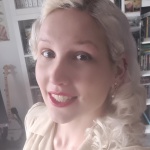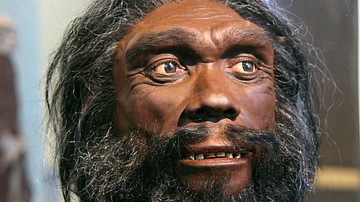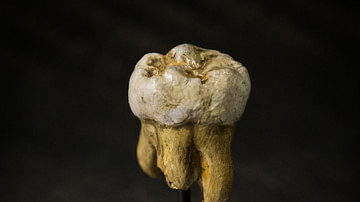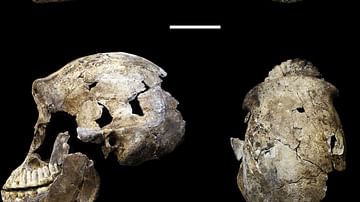Disregarding the extremely inhospitable spots even the most stubborn of us have enough common sense to avoid, humans have managed to cover an extraordinary amount of territory on this earth. Go back 200,000 years, however, and Homo sapiens was only a newly budding species developing in Africa, while perceived ancestors such as Homo erectus and Homo heidelbergensis had already travelled beyond Africa to explore parts of Eurasia, and sister species like the Neanderthal and Denisovan would traipse around there way before we did, too. Meanwhile, the wake-up calls of Homo floresiensis, found in Indonesia, and Homo naledi from South Africa (which do not seem to fit with previous, more linear models) serve as excellent reminders that the story of human migrations across the prehistoric landscape is far from a simple one.
How, when, and why both fellow Homo species and our own Homo sapiens started moving all over the place is hotly debated. The story of early human migration covers such an immense time span and area that there cannot be but one explanation for all of these groups of adventurous hunter-gatherers going wandering around. Where for some groups a change in climate may have pushed them to seek more hospitable lands, others may have been looking for better food sources, avoiding hostile or competing neighbours, or may have simply been curious risk-takers wanting a change of scenery. This puzzle is further complicated by the fact that only a highly fragmentary fossil record exists (and we do not know exactly how fragmentary it is, or which bits are missing). Recently, the field of genetics has shot to the forefront by analysing ancient DNA, adding to the fossil, climatic, and geological data, so that hopefully we can attempt to piece together a story from all these titbits.

This story will keep changing, however - at least in the details but perhaps even amounting to considerable overhauls - as new bones are dug up, tools are found, and more DNA is studied with increasing accuracy. Here, a basic overview will be provided based on what we think we know right now, alongside a discussion of the possible motivations these many different early humans may have had to migrate away from their homelands, across the far reaches of our globe.
Early transcontinental adventurers
Already millions of years ago, middle and late Miocene hominoids – among which were the ancestors of our species of Homo as well as of the great apes – were present not just in Africa but also in parts of Eurasia. Our own branch developed in Africa, though; the Australopithecines, our supposed ancestors, lived in East and South Africa's grasslands. The earliest Homo to be securely found outside of Africa seems to be Homo erectus around 2 million years ago, and when interpreted in the broad sense (there is some dispute over which fossils should be included within the species) it is seen to have set the bar high, spanning an impressive geographical range indeed.
However, the very tricky to place species of Homo floresiensis (nicknamed 'hobbit'), found at Liang Bua in Indonesia, must be named, too; it may be descendant from a very early (before or not long after Erectus) and still unknown migration from Africa. Clues are trickling in about migrations of people possibly predating Homo erectus, anyway. By now, five or six sites in Eurasia together span an suggested timeframe of roughly 2,6-2 million years ago, sporting tools made by as of yet unknown species; recent finds at Shangchen in the southern Chinese Loess Plateau, for instance, indicate hominin occupation there that dates back as far as 2,1 million years ago. Palaeoanthropologist John Hawks suspects that 'there were many movements and dispersals from Africa and back into Africa, starting much earlier than 2 million years ago and extending up to the most recent.' (Hawks, 12 July 2018). The main model followed today – that of Erectus being the first globetrotting humans spreading out from Africa across Eurasia – does not seem to account for all the evidence cropping up today. But, seeing that we do not have enough material yet to flesh out a more complex story, Homo erectus must still play a feature role in our story of early human migration.
Popping up in East Africa at sites such as Olduvai Gorge in the Turkana Basin in Kenya, from roughly 1,9 million years ago onwards, Homo erectus is also seen in South and North Africa. They are generally thought to have gone wandering out of Africa by 1,9-1,8 million years ago, travelling through the Middle East and the Caucasus and onwards towards Indonesia and China, which they reached around 1,7-1,6 million years ago. Erectus may even have braved the normally cold north of China in a period with somewhat milder temperatures, as early as roughly 800,000 years ago.
The follow-up crew
Erectus had set the trend for far-reaching early human migration, and their successors would push the boundaries further still. By around 700,000 years ago (and perhaps as early as 780,000 years ago), Homo heidelbergensis is thought to have developed from Homo erectus within Africa. There, different bands made territories within East, South, and North Africa their own. Of course, migration within Africa itself also occurred, in general.
From there on, a particularly energetic group of Homo heidelbergensis spread out all the way through western Eurasia, crossing the major mountain ranges of Europe and making it as far north as England and Germany. This is Ice Age Europe we are talking about, and these humans would have had to flow along with the often-changing climate; they were quite good at coping with the colder conditions of Europe and were able to survive on the southern edge of the subarctic zone, but naturally avoided the actual ice sheets. Evidence from Pakefield and Happisburgh in England, for instance, shows that early humans around 700,000 years ago were indeed able to make it this far north when the climate was more temperate, while they probably edged back into southern refuges during colder stages.
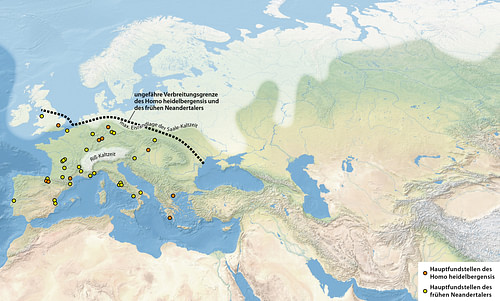
Homo Sapiens Spreads out
Meanwhile, what we call Homo sapiens gradually began to emerge, most likely from Heidelbergensis ancestors within the rich territories of Africa, in either Africa's southern or eastern reaches, by at least 200,000 years ago. Many sites have been found in both these regions that show that early bands of anatomically modern humans successfully lived there. However, they were not alone; the discovery in 2013 CE of Homo naledi in South Africa's Rising Star Cave, whose fossils were dated to between 236,000-335,000 years old, adds more players to the African stage. Already around c. 315,000 years ago, a species with some modern human features but also some archaic ones – possibly making them a precursor to Sapiens, or a related side-branch – lived out at Jebel Irhoud in Morocco, Northern Africa, too. Genetic evidence furthermore seems to suggest that our modern human ancestors may well have had company from other ancient groups that were related to them in varying degrees. The story of hominin evolution is not one in which single species succeeded each other; it was rather a complex mosaic of different players, many of them likely interbreeding and/or overlapping in terms of timeframe.
From Africa, members of the branch that is related to us modern humans formed migrated away from their homelands and into the Near East, where Homo sapiens burials have been uncovered at the sites of Skhul and Qafzeh in Israel, dated to between 90,000 and a staggering 130,000 years old, respectively. Similarly, the site of Jebel Faya in the United Arab Emirates seems to show through the tools that were found there that Homo sapiens may have migrated here as early as 130,000 years ago, too. Even older migrations are not exactly unlikely, either, as fossils that appear to be Homo sapiens (although some alternatives have been suggested, too) found at Misliya Cave in Israel were recently found and dated to c. 180,000 years ago. Far from there being one, singular big migration of one species to far-flung areas – which does not really make sense if you think about it, anyway – there appear to have been multiple instances of adventurous people moving about.
A recent study has shown that some of these early adventurers made it all the way to the island of Sumatra in western Indonesia between 73,000 and 63,000 years ago; this ties in well with other evidence that hints at humans reaching inner Southeast Asia some time before 60,000 years ago, and then following the retreating glaciers up towards the north. There is even new evidence that places humans in the north of Australia by 65,000 years ago, seemingly also stemming from an early migration.
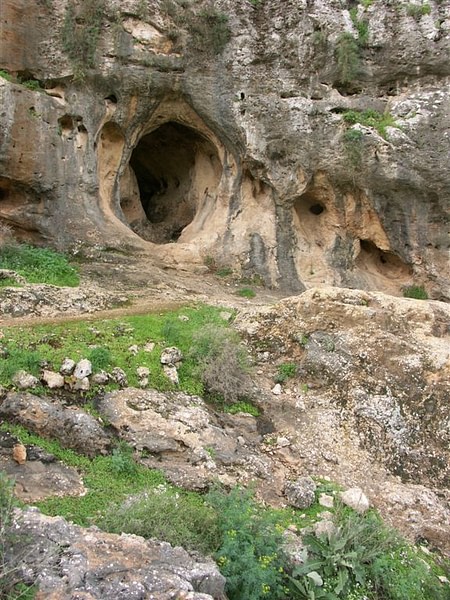
But which route did they take on this huge trek? Regarding possible ways out of Africa, Egypt is an option, but so is a journey through 'wet' corridors in the Sahara, through East Africa and into the Levant. Once out, we know through genetic research that in this Near Eastern setting, humans met Neanderthals and interbred with them (not for the first time, by the way: physical contact with them dates back to at least 100,000 years ago), after which an offshoot branched off and eventually migrated into Europe around 45,000 years ago.
Within Europe, modern humans probably dispersed rapidly, as hinted at by new evidence for their seemingly early arrival in southern Spain (for instance at Bajondillo Cave, Málaga) c. 43,000 years ago. In such a scenario of consistent and quick spread throughout Europe, the use of coastal corridors may have played a role. Homo sapiens also continued towards the east, though, probably all the way along the coastline, through India and into Southeast Asia, where they may have bumped into the possibly resident Denisovans and interbred with them (it is clear interbreeding happened somewhere, and the most likely location seems to be Southeast Asia).
All of this apparently happened at record speed; already by 53,000 years ago, descendants of that main wave out of Africa reached the north of Australia, the south taking until around 41,000 years ago. Reaching it was not straightforward, though. Although sea levels were about 100 meters lower than today, there was still a slightly inconvenient amount of water – a stretch of some 70 km – standing in between these early Homo sapiens in Asia and the landmass that included Australia, Tasmania, and New Guinea. Rather than surviving such an ambitious swim, they probably built boats or rafts to help them on this gutsy crossing.
Meanwhile, within Asia, a migration towards the north of East Asia could have begun around 40,000 years ago, paving the way to the Bering Land Bridge – a happy grassland steppe-covered side effect of the Ice Age, connecting Asia to the Americas. Humans are usually thought to have reached the Americas through this route, by around 15,000 years ago, expanding downwards along the coast or through an ice-free corridor in the interior, but this is far from a closed case. After this, there were some last strongholds that remained human-free for a long time still, such as Hawaii – reached by boat around 100 CE – and New Zealand, which held out until around 1000 CE.
Possible driving forces
The question of why these prehistoric people decided to leave and move somewhere else is a tough nut to crack, especially considering we are looking at a time that predates written sources. Migration is generally seen a result of push and pull factors, though, so that is a place to start. Push factors relate to the circumstances that can make someone's homeland an unpleasant enough place for them to ditch it entirely in favour of something new. With regard to these early human migrations, of course 'no jobs' or 'terrible political circumstances' do not apply; rather, think of stuff like the climate taking a turn for the worse and turning places into huge ovens or freezers where barely anything can live or grow, natural disasters, competition with hostile neighbouring groups, food and other resources running too low to support the amount of people within an area, or the more mobile type of food (herds of herbivores) migrating away.
Pull factors, on the other hand, involve the draw of new possibilities and rewards; basically, the more favourable side of the things mentioned in the 'push' section, such as greener lands with better climates and luscious amounts of food and resources. Of course, this is a bit of a simplification, and it will be hard to track down the exact combination of factors that led to each individual instance of early human migration.
There are some prerequisites for successfully handling migration. It is stressful and dangerous – Homo erectus, for instance, most likely had no idea what they would find when they left Africa – and it challenges a group's resourcefulness and ability to adapt. If you move into a new environment, it helps to have adequate technology to help you tackle it; in this case, tools to successfully hunt and gather the resident animals and plants, or to protect yourself against colder areas via clothing or fire (the latter has been known by humans since probably at least 1,8 million years ago, but was not habitually used until probably between 500,000-400,000 years ago). Inventiveness and cooperation in securing new resources also help.
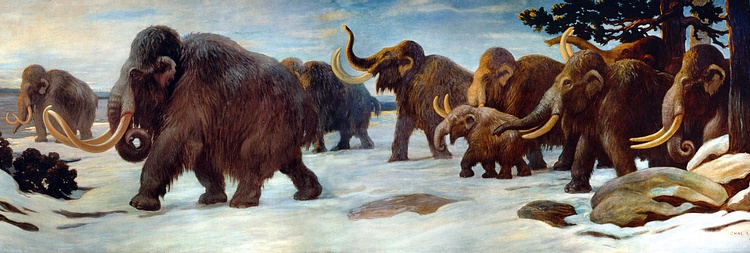
There was the slight problem of the Sahara standing between Homo sapiens and a possible way out, however. Other climate studies have shown, though, that there were 'wet' or 'green' phases during which more friendly corridors would have opened to form pathways across the Sahara, the timings of which seem to coincide with the major dispersal of humans leaving sub-Saharan Africa (identified wet periods are between roughly 50,000-c. 45,000 years ago and c. 120,000-c. 110,000 years ago). However, a recent study has shown that although the 'wet' phase holds up for Sapiens ' early migration into the Levant and Arabia between roughly 120,000-90,000 years ago, during the time of the main migration (around 55,000 years ago) the Horn of Africa was actually really dry, arid, and a bit colder. This may, then, have helped push the main wave out.
Another instance in which the impact of the climate on early human migration seems to become visible occurs even earlier. Around 870,000 years ago, temperatures dropped, and both North Africa and eastern Europe became a lot more arid than before. This may have caused large herbivores to migrate into southern European refuges, with early humans following hard on their tails. At the same time, the Po Valley in northern Italy first opened up and formed a pathway for possible migration into southern France and beyond. This ties in pretty well with Homo heidelbergensis making its way into Europe. Following herds of large herbivores would have been a good strategy in the challenging process of migration, anyway, and a 2016 CE study suggests Homo erectus may also have done this, while also sticking close to flint deposits and avoiding areas with loads of carnivores, at least early on in their dispersal.
Whatever the exact driving forces or the exact difficulties early humans ran into en route, as time passed adaptability reigned supreme and humans – starting with Homo erectus and culminating in Homo sapiens' greedy dispersal - spread across the whole wide world.
Blind spots
There are obviously a lot of holes in this story, though, and it cannot hurt to explicitly name some of the blind spots we have to take into consideration at this point in time. As a whole, the dates mentioned above are only our best estimates based on our interpretation of the data we have gathered so far. Some areas in which the story can be fleshed out a lot more if we can get our hands on more evidence are found below.
The Denisovans, for instance, are known to us only through one finger bone and three molars found in a cave in Siberia, and through their DNA (their genome was sequenced in 2010 CE) which seems to imply they ranged from there all the way to Southeast Asia. It is moreover possible that they interbred with an unknown archaic human, which would obviously tell a story of its own. Fossils of these mysterious humans would be very welcome in trying to fill in the picture of their life and their movement. Another enigmatic species is Homo floresiensis; exactly how and when did they get to the island of Flores (and did they somehow use boats at this very early point in time)? Who were their ancestors? More evidence is required to seal the deal on this.
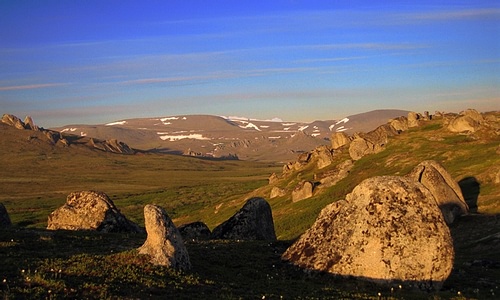
More evidence is clearly needed before this can overwrite the current story regarding the Americas, but it forms a good example of what could happen to our current image of early human migration as new discoveries are made. We certainly cannot paint a complete and finished picture yet.

